Retro Charger zooms forward with 797 horsepower
Filed under: Weekly test drives, Autos
By John Gilbert
Whatever the record number of classic retro Dodge Charger muscle cars is, I can’t imagine it topping the estimated 3,000 that were spread across the Washington County Fairgrounds just outside of Stillwater, Minnesota, in a colorful display of the annual “Mopars in the Park” gathering.
But we also have to admit that Dodge, or Chrysler Corporation, or Fiat-Chrysler, or now Stellantis — the name of its newest conglomerate — has been cheating. Sure, there are new Mustangs and Camaros, which are easily distinguished from the classic old Mustangs and Camaros, but when it comes to Mopars, they just keep on building the new muscle cars to greatly resemble the old, vintage, classic muscle cars of the 1969-70 era.
The new Challenger pony car is the best example of the recurring family resemblance, but the new Dodge Charger also has a distinct retro look to it, while being loaded with new, high-tech equipment.
If we want to trace the Charger alone, we note that the basic Charger is a pretty mean-looking beast, and then we can move up by adding appendages onto its name to signify that its power has increased incrementally.
For example, when the Dodge SRT (Sports Racing Technology) team got involved, the big Hemi V8 was installed along with improved handling characteristics. Then the Dodge engineers, or more accurate the SRT guys, found a way to extract more power, so the Charger SRT Hellcat was born, with more power than any sane person could put to use anywhere but on a drag strip.
Couple years later, still more power was found, and the top model became the Dodge SRT Charger Hellcat Redeye. There were companion Challenger models, too, for those who preferred a 2-door coupe each step of the way up the power chart, but the Charger holds special charm because it is a nasty-looking 4-door family sedan to begin with.
The most recent boost in power is somewhere over the moon, and comes on a new and widened platform, presumably for stability in cornering. It all comes to us in the form of the 2021 Dodge Charger SRT Hellcat Redeye Widebody, and that is the one we’ve evolved to today as a topic that is mind-blowing on several different counts, and it sure is a blast to drive.

More lupines by Lake Superior, and well-contoured rear end houses two large exhaust tubes to clear the air from 797 horses.
The engine is a 6.2-liter Hemi V8, fitted with a supercharger that blows the power to the rear tires in what we might suggest is excessive — 797 horsepower and 707 foot-pounds of torque. The beefed up 8-speed automatic transmission keeps that power under control, and the wide body, coupled with 305-35 ZR 20 tires on 11-inch wide allow wheels, keep the car going where you aim it.
Of course, performance is the keynote of this car, and when you hammer the gas, the thrill of sudden motion is amplified by a spellbinding sound of power from under the hood. They say you can go 0-60 in about 3 seconds, maybe 3.5, but who’s keeping track? Actually, you can, by clicking over the adjustable instrument pod to where it will clock 0-60 times, as well as driver reaction times.
It’s far beyond the old drag-race line, “You snooze, you lose,” but it is fun to see how quickly you can respond to launch all that power going forward.
The car came painted “Smoke Show,” which is what the big-time drag-racers put on when they launch from the starting lights. It is Dodge’s version of the trendy new flat-gray color that has burst upon the auto scene in the last year or two. Never has it been more appropriate than on the Charger Hellcat Redeye Widebody, though, because you could undoubtedly light up the tires in a billowing cloud of tire smoke that would almost perfectly match the paint.
Wide black racing stripes run down the middle, from hood to trunklid, and the grooves and other trim contours set this vehicle apart from its mainstream brethren. The sticker price is another way to distinguish it, because every dose of power costs cubic dollars to attain, and the base Charter SRT starts at $69,995, while loading up all the specialty performance parts boosts it to $86,865.
That’s a lot of money, but it does get you into the stratosphere of specialty hot-rods.
Aside from attracting onlookers from other drivers, pedestrians, and inhabitants of police cruisers, there are some intriguing features of the Charger SRT Hellcat Redeye Widebody. First is that you sit in firm comfort in those bucket seats, and the rear seat occupants are comfortable too, and second, and most surprising, you can drive it every day and, if you can keep your foot off the gas, it will handle its daily duties with calm sophistication. Read more
Bronco Sport fills popular Ford SUV niche
Filed under: Weekly test drives, Autos
By John Gilbert
Vehicle buyers are nothing if not eager to jump onto whatever trendy bandwagon might be coming around the block. And manufacturers are quick and clever about heading off our desires with products we just can’t do without.
A perfect case in point is the new Ford Bronco, which is a compact SUV adorned with the beloved name out of the past, when Ford made a Bronco that was big and square and rugged and primitive, but would haul stuff and operate as a family utility vehicle before the term SUV had been dreamt up. Its ruggedness worked for adventurers who rambled off the beaten paths. It had two rows of seats and the rest was for stowage. It was not designed for comfort so much as for taking folks into the hinterlands, beyond roads.
In the years since the original Bronco bucked its way into history, Ford has fought the good fight about designing and building SUVs from the tiniest subcompact on up through the largest Expedition, with a half-dozen or more steps in between those extremes.
But as sophistication settles in, Ford has found a way to wedge an all-new compact SUV in among the Explorers, Escapes, Edges, Expeditions and all, and it did it right — even including revisiting the name Bronco. The new Bronco is a squarish but attractive body plunked down on the impressive drivetrain of the compact Escape, including the 2.0-liter EcoBoost 4-cylinder engine and 8-speed transmission.
An interesting wrinkle is that there are two Broncos — a normal Bronco and a Bronco Sport. The Bronco Sport is actually a bit smaller than the Bronco proper, and it shares unibody construction with the Escape. I have not yet driven the Bronco, but I have had some extensive test-drive time with the Bronco Sport, in fact it was the Bronco Sport Badlands edition, and along with more compact size, it comes with revised suspension, all-wheel drive, and rear cargo floor that is covered with a rubberized material that goes up the rear seat backrests. Read more
Nautilus, Corsair navigate Lincoln SUV pool
Filed under: Weekly test drives, Autos
By John Gilbert
Ford sets a strong pace with its industry-leading truck business, supporting the always-popular F-150 pickup with a fleet of SUVs that range from the gigantic Expedition to the Explorer and down to the Edge and Escape — plus the new Bronco — getting into the more compact vehicles. It is less noted that Ford branches out into the luxury category through its Lincoln arm, which used to feature luxury cars before going into luxury SUVs.
The gigantic Navigator is king of the Lincoln line, and it has gotten corporate support to be more than an Expedition with Bling. Next down in the Lincoln lineup is the Aviator, which is a rekindled name from the recent past on a new vehicle that can steal customers from the Navigator by being more maneuverable in traffic. The focus today, you should pardon the expression, is further down the order to the Nautilus and the Corsair, the newest pair of stylish SUVs that deserve consideration by anyone seeking a new niche — a capable luxury SUV that combines sporty flair and agility with that luxury. The Nautilus and Corsair both check those boxes..
Both carry nautical themes, with the Nautilus taking its name from the Jules Verne classic, “20,000 Leagues Under the Sea.” That was definitely appropriate when I spend a week with a Nautilus recently, its paint was beautiful, called Flight Blue, instead of something such as Deep-Sea Blue, while Flight Blue might be more appropriate on Aviators. The conditions made up for that transgression, though, when the bright, sunny day in Duluth, Minn., took a sudden turn and hit the area with a sudden, surprise thunderstorm.
My wife, Joan, and I were wandering through Target trying to remember what we needed at the time, and when we came out, the sky in the East had swapped its beautiful blue for a sullen black cloud heading out over Lake Superior. It passed quickly enough so the setting sun could illuminate its underside and create a sensational double rainbow. which arched up as though providing a halo for the Nautilus.
I couldn’t resist doing a quick-draw for my iPhone and firing off a few photos, one of which you can see here. We hopped inside as the last drops fell, and we didn’t get any wetness on the pristine whie leathre bucket seats, which complemented the luxury feel of the white-leather-trimmed steering wheel..
The Corsair is decidedly smaller than the Nautilus, though no less luxurious inside. Well, maybe a little less luxurious, but still plush enough to be no less comfortable and full of creature features. It was a glistening, metallic Pristine White, with an interior featuring smooth Beyond Blue leather seats.
These two cars stand on their own, but for folks like me, who can’t resist digging beneath the sticker sheet, the Nautilus is based on the Explorer platform and powertrains, while the Corsair is lower, smaller and lighter, built on the same platform and drivetrain as the Escape, which also serves the new Bronco.
The Nautilus was powered by Ford’s potent 2.7-liter V6 with 335 horsepower and 380 foot-pounds of torque. thanks to twin-turbochargers pumping air into the combustion chambers, with an 8-speed automatic. Its sticker was $68,295, which tells you how well equipped the Black Label model is, because its base price is $65,090, and the only options added on were enhanced active park assist, 360-degree camera, lane-centering in its adaptive cruise control, a cargo utility package, the roof rack with satin side rails, and the ultra-comfort 22-way power seats.
The Corsair, on the other hand, jumped from a $45,090 base to $57,680 with the technology package, sport package, “perfect position” 24-way power leather seats, and adaptive suspension.It was powered by a very capable 295 horses and 310 foot-pounds of torque, from a 2.3-liter 4-cylinder, also turbocharged. All the prescribed safety assets are included, as is a 14-speaker Revel audio system, plus stop-start and remote starting.
Regular readers of this column are well aware that I prefer more compact vehicles for their agility and fuel-efficiency benefits over gigantic vehicles with lots of power to move but a commensurate decrease in miles per gallon, and comparing these two earns my usual choice. The Nautilus 2.7 V6 could stretch out and get over 20 mpg, although it was in the 17-18 range in city driving. The Corsair routinely got up to mid-20s, although the EPA estimated 28 highway was a stretch.
The Nautilus is not too big, and in my mind has a clear advantages over, say, the Navigator,. Bu tits edge in quickness fades against the smaller Corsair, which feels quicker and more agile in comparison. The Nautilus has a bit more plush comfort, although it is still firm enough on corners to feel sporty. Conversely, the more compact Corsair, while sportier, is still plenty compliant and comfortable.
Both vehicles had all-wheel drive, as well as 8-speed automatics, but features such as paddle shifters rdon’t seem as significant on the larger Nautilus. On the Corsair, paddles add a definite dash of sportiness, and in Duluth, they are very useful when you want to downshift while descending all those hills. You can probably add a couple years to your brake life by using the paddles to hold your speed under the pace that gravity could help hurtle you into the big lake if you didn’t watch it.
The seats in both vehicles have obviously received special attention from engineers, who have seen to it that being a Lincoln should mean more luxury and comfort than the equivalent version wearing Ford insignias. The seats design and structure definitely works to accomplish that objective.
Both the Nautilus and Corsair are major pluses for Lincoln, which has spent its lifetime trying to earn respect from its more popular Ford siblings. And the Nautilus and Corsair both have enough to offer to lure customers to visit the showroom, and a short test drive in either one might convince a prospective customer to go Lincoln.
Page, Durango SRT link 50 years of Mopar
Filed under: Weekly test drives, Autos
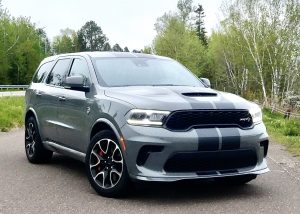
The 2021 Dodge Durango SRT Hellcat packs 702 supercharged horsepower into an SUV that is a throwback to the 1970s muscle cars.
By John Gilbert
The timing was almost perfect, because I had just finished a test-drive week in a 2021 Dodge Durango SRT Hellcat, which is both futuristic and retro, when I got contacted by Wes Eisenschenk, who compiles endless research on finding and writing about Lost Muscle Cars.
The “perfect” part of the timing was because the new Durango SRT comes loaded with all the latest developments that Dodge’s Mopar team, previously known as SRT — for Sports Racing Technology — including a supercharged 6.2-liter monster V8, with 702 Hemi horsepower, right out of the Hellcats, with all-wheel drive added for proper SUV potential. It looks the part of an all-out high-performance monster, and it joins current Charger and Challenger Hellcat models as the closest thing on the streets to a throwback to the 1969-72 era, when Dodge and Plymouth muscle cars were the terror of drag strips. Those included Minnesota Dragways and later Donnybrooke Speedway, which became Brainerd International Raceway.
One of the highlights of my time covering such race tracks for the Minneapolis Tribune was when I made a suggestion to the late Jerry Perkl, the imaginative and hyper-active proprietor of White Bear Dodge, which he turned into the motorsports pinnacle of Dodge dealers. I suggested that with the new “Plum Crazy” color of purple that graced the new Dodges, he should set up a hot-rod Charger for Alan Page, who had become a legendary part of the Vikings “Fearsome Foursome” defensive line for his amazingly quick starts that challenged the referee’s ability to detect whether he had vaulted offside.
Perkl swung into action immediately and got it done. For a proper race, Page needed an opponent, and, because I also covered North Stars hockey, I suggested young defenseman Barry Gibbs. So Perkl pulled his display specialty — a high-winged 1969 Dodge Daytona Charger — off the display and set it up for Gibbs for a Minnesota Dragways exhibition match race.
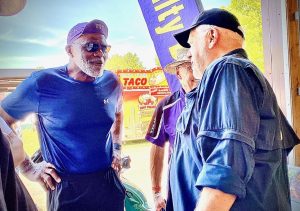
Alan Page talked to John Gilbert at the Mopars in the Park event in Stillwater. — Photo by Jack Gilbert.
Eisenschenk got Page to show up with replicas of those two cars, now privately owned, for an autograph session at the 37th annual “Mopars in the Park” event in mid-June at the Washington County Fairgrounds near Stillwater, Minnesota. In his research, he found a feature I had written in the Minneapolis Tribune archives, and when he finally traced me to Duluth, he was astounded that I had gotten a scoop on the story because I had suggested it in the first place. So he pleaded with me to come down to the event and appear along with Page and the cars. It didn’t take more than an invitation.
The only reason I referred to the idea of the big show being “almost” perfect, incidentally, is that the temperature hit an honest 102 degrees in Stillwater on that June 5 Saturday. It was so hot it also got up- near 100 in Northern Minnesota. The scorching heat was the only flaw in an incredible event. “Mopars in the Park” attracts owners of classic old Dodges and Plymouths, and this year’s event filled acres and acres filled with an estimated 3,000 Mopar hot rods, brightly painted and polished and almost all in the classic, 50-year-old perfection.
Wes had pulled off a coup by locating operational replicas of the original Plum Crazy Dodge Charger and the White Bear Dodge Daytona Charger with the giant rear wing. Perkl reettered the Charger to call it “Vikings Purple.”
Page came out and sat in that sizzling weather for a couple of hours, signing autographs and letting people take hundreds of pictures posing with him, the former Vikings star who then became a Minnesota Supreme Court justice.
The similarity of those 1970-era Chargers and this new version of 21st Century Chargers and Challengers is that the newest Challengers look nearly identical to the vintage ones that never reached this kind of popularity 50 years ago, when competing with Mustangs, Camaros, Barracudas, Firebirds and Javelins in the ponycar marketing battles. But they do have the new high-tech powerplants with the same throaty rumble that might best be described as ground-shaking.
The sophistication of the Hellcat powertrain from the contemporary Chargers and Challengers being stuffed into the Durango SUV is a brilliant move by the fellows from Mopar, which builds the SRT engines, to bring alive a neat large SUV that was just crying out for a dose of hot-rod inspirtion.
The vehicle I had test-driven just before the event came in a special Destroyer Gray, with a wide dual-black stripe running over the roof and all the way down in the front and rear. That, and the other graphics set the SRT Hellcat version apart and above the garden-variety Durangos, which compete well enough with the countless other mid to large SUVs in versatility and utility, but the SRT treatment thrusts the Durango into its own category.
The upgrades to the SRT Hellcat version starts with the engine. It is a 6.2-liter Hemi V8, supercharged to reach 702 horsepower, and the 8-speed automatic is not only heavy-duty but it shifts with amazing smoothness. When you take off hard, you hear the roar of the engine, and then you hear the shift points even though you don’t feel anything as it shifts.
The black interior adds the proper sinister demeanor, and the front bucket seats with suede and leather grip you firmly in a comfortable cocoon. The heavy steering feel is welcome, and the paddle-shift levers are readily operable when you want to manually control your shifting, and if you use them, you must keep using the paddles until such time as you hold the right paddle on for a few seconds, which puts you back into automatic mode.
All imaginable luxury and safety features are included, and everything not included as standard for the $80,995 sticker are added in the option list that boosts the price up to $89,665. That would include blind-spot, lane-departure and adaptive cruise, with rear backup assist monitoring and front collision aid — as well as such classy touches as a suede leather headliner to make you not regret missing out on a sunroof.
Mingling with the vintage Mopars, I was surprised to find that Wes Eisenschenk had enlarged a reprint of my story in the Minneapolis Tribune that told all about the upcoming match race at Minnesota Dragways between Alan Page and Barry Gibbs. A highlight of the sweltering afternoon — thank heaven we were in a building — was my reacquainting with Page. He remembered that I had written about and arranged the details, although he probably didn’t remember that I had also written a few Vikings NFL sidebar stories when he played. Page, of course, looks fantastic and is probably lighter than he was in high school, let alone college or pro.
He also put to rest a story that had become legend, about how the publicity from my stories led the Vikings to demand that he stop drag-racing because of the inherent danger of racing.
“No,” said Page, “nobody from the Vikings ever told me I couldn’t race.”
Come to think of it, Page was so strong-willed, he had several standoffs with the Vikings, such as staying light and in healthy shape to be the quickest defensive lineman in the NFL, when they wanted him to bulk up. So if they had insisted he stop racing, it might have been impossible to pull off.
We had a great conversation about the current Vikings, and I told him I was still writing about all sports, as well as cars, for the Duluth Reader. We also had a good segment about my annoyance that after Case Keenum came off the bench to lead the Vikings to an 11-3 record, the Vikings decided he wasn’t good enough for them and went after Kirk Cousins. I said my feeling was that chemistry was vital to a successful team — much as the Vikings of Page’s time proved — and Keenum gave them the best chemistry they had for decades, with the exception of the Brett Favre years.
“He certainly had an exceptional season with them,” Page acknowledged, diplomatically.
I was thinking it was too bad I wasn’t still driving the SRT Hellcat Durango for that trip, and too bad it wasn’t Plum Crazy, because it would have been the perfect vehicle for Alan Page to drive home as his own.
Tremors big and small shake up Ford rivals
Filed under: Weekly test drives, Autos
By John Gilbert
Everybody who drives any kind of vehicle is aware how incredible pickup truck popularity has become, Ford, the king of the pickup game, has now just about reached the most far-out extremes in building and planning off-road capable pickups. But it keeps adding more.
After I had driven just about every size and strength variety of pickups that Ford builds, including F-150, F-250, F-350, Ranger, and specialty models like the Raptor, I figured I had tried them all, and been impressed by nearly all. Then I got a new test drive, and it was the Ford F-250 Super Duty “Tremor” pickup. Or, more accurately, the “2021 F-250 SRW 4×4 Crew Cab Platinum 160-inch wheelbase Styleside Tremor” pickup.
That comes with Ford’s 7.3-liter fuel-injected V8 monster gasoline engine with a 10-speed automatic, and the Tremor monicker is emblazoned on the rear flanks just to designate the off-road trim and capability built within — a package that includes off-roading specialty items such as heavy-duty skid plates, a 10,000-pound gross vehicle weight package, chrome tow hooks, a 4.30 rear axle ratio, and the whole thing is raised enough so be perfect for an Olympic year, because you might need high-jumping skills to get in easily, even with the fixed running-board.
It is, basically, a heavy-duty variant on the theme of Ford’s vastly upgraded Raptor off-road F-150, but this one is only on the F-250 medium-sized Super Duty, with all its bolstered underpinnings. If it’s hard to imagine an F-250 version of a Raptor, it is less difficult after spending a few days with the Tremor.
The long and short of it is that Ford complements the F-250 monster with a Tremor version of its compact Ranger pickup, as well, and I got them back-to-back, just for comparison purposes.
If an actual tremor describes the earth trembling when an earthquake shakes the ground, the full force of a 7.3-liter V8 pulling a trailer or hauling a full load, or climbing rocks the size of mountains, certainly offers enough of a resemblance to justify the name.
On top of its powerful capabilities and upscale interior, the F-250 Tremor came in a stunning dark blue color, called “Antimatter Blue,” with black leather seats. And yes, it costs a bit — the test vehicle rose from $65,000 to $73,825 after all the options are tallied.
When the car distribution fellows came to pick up that F-250 Tremor, they replaced it in my driveway with another Ford pickup — a 2021 Ranger midsize pickup, one which also had the word “Tremor” emblazoned on its rear sides. Yes, Ford has expanded its specialty off-road truck fleet to include an oversized one, and also a compact one. The Ranger also was a SuperCrew model, and had a 5-foot box , and it was painted Velocity Blue — a lighter color than its big, F-250 brother. Tremors, of course, come in various degrees, so having them of different sizes makes sense.
Everything came equipped on the test Ranger, which stickered for $34,745 with the 2.3-liter EcoBoost (turbocharged) 4-cylinder engine and 10-speed automatic, and it climbed $10,000, to $44,430, when you added the XLT series trim, the Tremor off-road package, remote start, the technology package, and the Tremor goodies and graphics.
If you need the heavy-duty capabilities, the F-250 is your answer, but if you want to go dashing off-road a bit, but mainly want to maneuver through traffic and park with ease in tight areas while also announcing to the world that you could veer off-road at any moment, the Ranger version is the perfect bookend at the compact end.
Interestingly, while I got 12.5 miles per gallon with the F-250 Tremor, I only managed to get up to 18.5 mpg with the lightweight Ranger model. I would like more from the F-250, but understand how thirsty the 7.3 V8 is, but I also expected more from the turbo 4 in the Ranger.
The reason those two trucks being introduced are almost ironic, of course, is that the big news from Ford in the May was that it will be coming out with an all-electric version of the F-150, which will have spectacular, and silent, power, and will give you all the towing and hauling capability you can imagine, and will also be strictly a plug-in, rechargeable vehicle, a full EV. It will even have a generator stashed and connected to the high-output battery pack that can take care of supplying all the demands your house might have in the event a power failure knocks out your electricity.
It seems that the hard-core pickup buyers might be the last and most reluctant to give up their gasoline engines, no matter how poor their fuel economy might be. But if Ford can pull off the switch to an electric F-150, we will be fascinated to watch the transition. And it will be anticlimactic to sit here and quibble about the fuel economy of a gigantic V8 or a turbo EcoBoost 4-cylinder if Ford is using them as an effective smoke screen while it sneaks out its silent EV version virtually behind our backs.
Me? I’m waiting to try out what is sure to be coming soon — an all-electric F-150 Raptor. With or without Tremor trim.


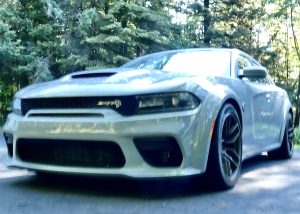
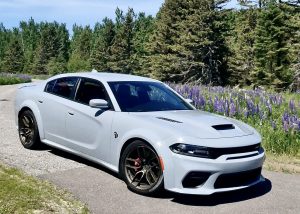
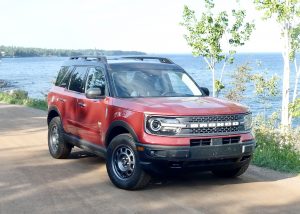
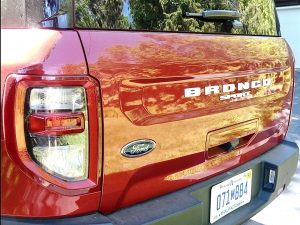

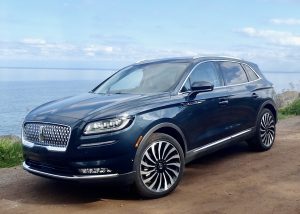
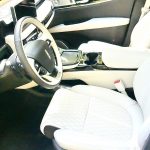
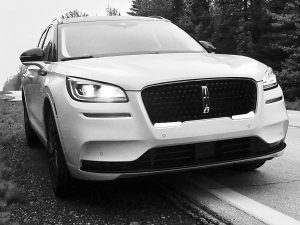
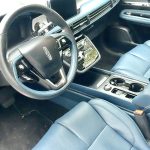
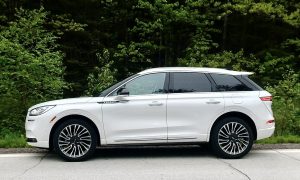
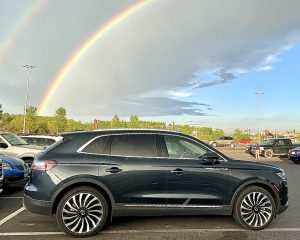

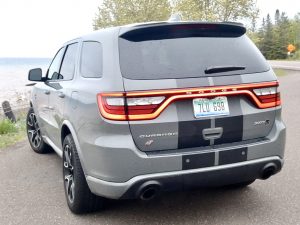

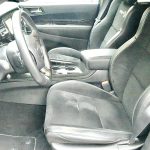
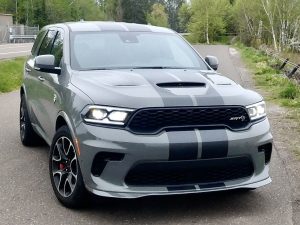
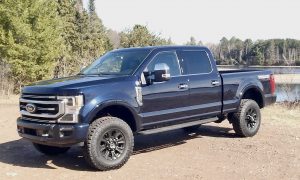
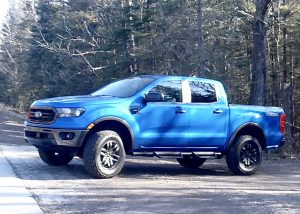
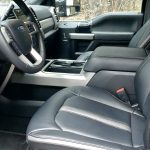
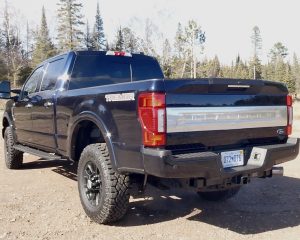

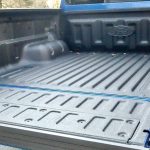
 John Gilbert is a lifetime Minnesotan and career journalist, specializing in cars and sports during and since spending 30 years at the Minneapolis Tribune, now the Star Tribune. More recently, he has continued translating the high-tech world of autos and sharing his passionate insights as a freelance writer/photographer/broadcaster. A member of the prestigious North American Car and Truck of the Year jury since 1993. John can be heard Monday-Friday from 9-11am on 610 KDAL(www.kdal610.com) on the "John Gilbert Show," and writes a column in the Duluth Reader.
John Gilbert is a lifetime Minnesotan and career journalist, specializing in cars and sports during and since spending 30 years at the Minneapolis Tribune, now the Star Tribune. More recently, he has continued translating the high-tech world of autos and sharing his passionate insights as a freelance writer/photographer/broadcaster. A member of the prestigious North American Car and Truck of the Year jury since 1993. John can be heard Monday-Friday from 9-11am on 610 KDAL(www.kdal610.com) on the "John Gilbert Show," and writes a column in the Duluth Reader.